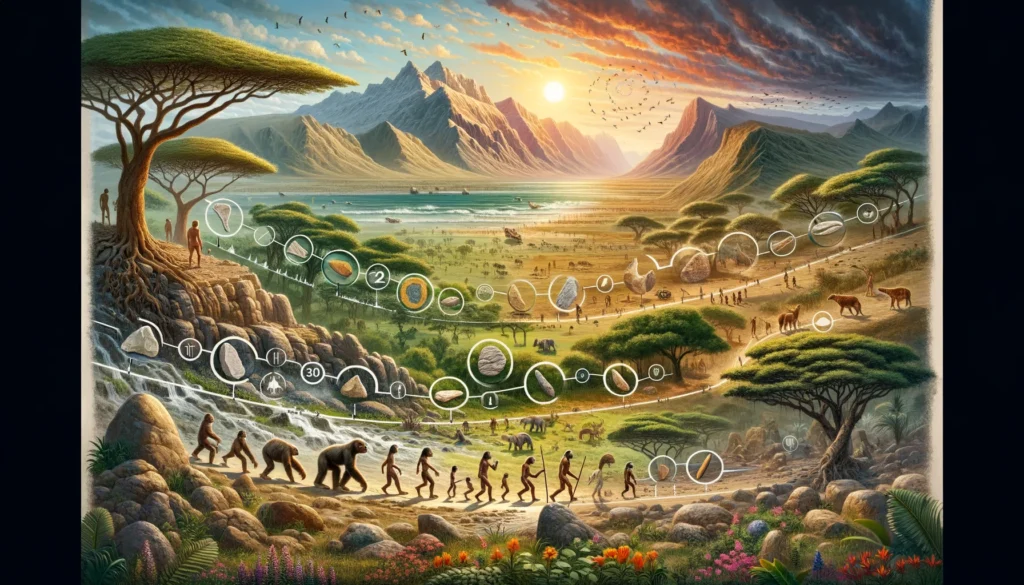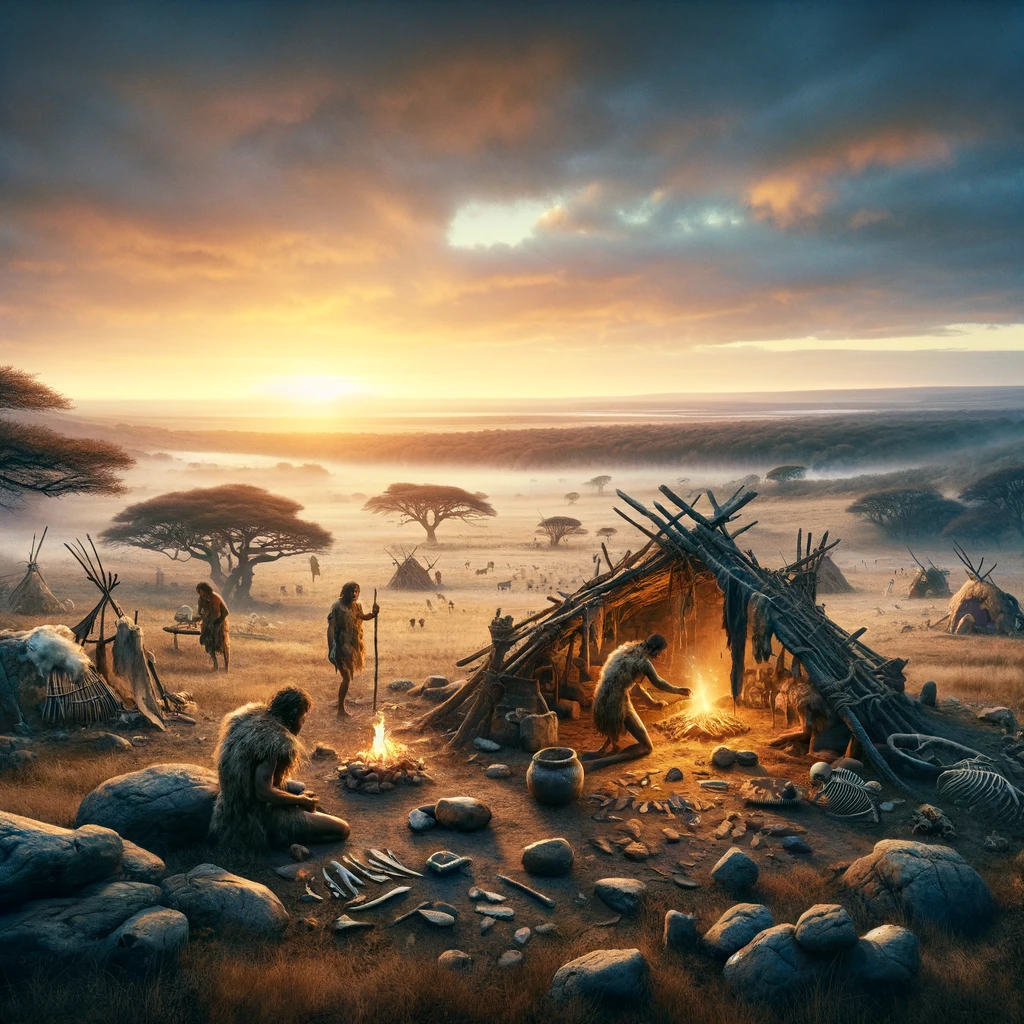Take an expansive journey back through over 3 million years of human prehistory analyzing the hunter-gatherer communities that catalyzed early human advancement.
Surviving and evolving across hundreds of thousands of years, Paleolithic societies developed foundational tools, technologies, and cultural practices that Allowed our earliest human ancestors to populate the farthest corners of the Earth. This article will navigate through the major phases of the Old Stone Age highlighting evolutionary milestones, lifestyle habits, tool-making innovations, creative outlet, and migratory patterns that permitted small bands of foraging Homo sapiens and precursor hominins to flourish in often extreme environments.
Setting the Timeline and Scene

Spanning an incredible expanse between approximately 3.3 million years ago to around 11,700 years ago, the Paleolithic Era unfolds across three definitive periods – the Early, Middle, and Late Stone Ages. In the Early Paleolithic from 3 million years ago as the first crude stone tools called Oldowan pebble cores and flakes were manufactured, humanity’s earliest ancestors such as Australopithecus and evolving members of the Homo genus like Homo habilis and eventually Homo erectus stalked the woodlands and grasslands of East Africa.
Progressing into the Middle Paleolithic era by 300,000 years ago, now relatively larger-brained hominins like Homo Heidelbergensis and archaic anatomical Homo sapiens utilized handaxes and spears to target big game while ultimately crossing out of Africa into Europe and Asia for the first time. Neanderthals later dominated this middle period. Finally, anatomically modern Homo sapiens fully emerged sometime before 200,000 years ago to command the Late Paleolithic world with intricate blades, projectile points, and abstract engravings while migrating across most continents.
Surviving and Thriving as Hunter-Gatherers

Absent domesticated plants and animals, Paleolithic groups subsisted by harnessing a rich awareness of seasonal food sources and animal behaviors to facilitate hunting and foraging trips. Typically small in size rarely exceeding 50 to 100 individuals, these mobile communities often structured necessary tasks like childrearing and gathering roots/berries around gender norms. Leadership was likely achieved through demonstrated experience rather than hereditary lines. Some archaeological evidence suggests larger periodic gatherings between bands possibly for important rituals or exchange of marriage partners.
Since frequent mobility was key, material possessions were generally minimalistic – stone tools transported in animal-skin packs or seafood gathering baskets woven from grasses. Temporary structures ranged from rocky overhangs to huts of timber and mammoth bone. Clothing of tanned leather, felted fur, and sinew protected against intense cold as human ranges expanded. Fire brought warmth along with the social glue of communal cooking.
Chipping Away at Stone Tool Technology

The manufacture and continuous refinement of lithic tools synonymous with the Paleolithic Era traces an evolutionary arc of human cognition and adaptability. From the crude, golf ball-sized Oldowan choppers of the earliest toolmakers to the delicate Solutrean laurel leaf spear points crafted by Magdalenian Europeans 16,000 years ago, stone knapping technology enabled our primitive ancestors to not just survive but expand across the world.
These tools ranged from hefty cutting implements like handaxes, cleavers, and scrapers to slim, aerodynamic projectiles like javelin tips and arrowheads. Bindings, handles, and compounds like birch tar provided functionality. Trade networks spread across continents as new stone materials like obsidian offered sharper abilities. By the closing millennia of the last Ice Age, delicate burins were being manufactured to shape specialized bone points and intricate needles.
Expressing an Emerging Mind

While language capacities remain hotly debated without writings, a cultural complexity manifesting symbolically appears undeniably woven into the Paleolithic world. From purposeful ochre body paint to intricate patterns engraved into ostrich eggshells, archaic humans imbued their environments with meaning. By 65,000 years ago, cave artwork sprouts across Ice Age Eurasia from animal shapes in Indonesia to dynamic Spanish frescoes of stampeding bison.
Discerning any definitive meaning proves challenging but certain messages resonate. Hand outlines intimate a primal impulse for connection and to mark existence. Half-human therianthropes merging attributes of man and beast potentially signal supernatural beliefs or myth-making. Dots and geometric designs hint at mental abstractions and time-keeping. Man once seen as brutishly primitive appears endowed with imagination, wonder, whimsy that still speak to us today.
Migrations That Shaped Our World

Scholars traditionally cast Homo sapiens as arising in Africa around 300,000 years ago before commencing migrations out into Asia and Europe starting about 100,000 years ago along coasts and savannas in multiple waves. However, recent discoveries like Middle Pleistocene tools in China dating back 2.1 million years question this simplicity. Hominins clearly expanded ranges far earlier.
Whatever the exact chronology, encounters between archaic and modern humans by 50,000 years ago interlaced our genetics. Small bands crossed Siberia into the Americas. Island hopping led to Melanesia and Australia. Harsh Northern Europe fell to human spears and mammoth-ivory homes. Trading patterns entwined communities separated by thousands of miles. Such arduous travel underscores a flexibility and ingenuity that became hallmarks of ancestral lifeways.
FAQs about the Paleolithic Era

- What does the term “Paleolithic” mean?
- Paleolithic translates to the “Old Stone Age” referring to the widespread use of chipped stone tools by hunting-gathering humans during this over 3-million-year period preceding the Neolithic revolution.
- What did Paleolithic people typically eat?
- Hunter-gatherer bands subsisted off hunted wild game like deer and rabbits along with foraged nuts, fruits, seeds, roots, and honey depending on local biomes. Fish, shellfish, birds, eggs, and insects supplemented diets.
- How do we know about Paleolithic life if there was no writing?
- Archaeology provides books of information from excavated stone tools, campsite remains, bones, and artwork to reconstruct lifestyles. Advances let us extract ancient DNA, isotopes, and pollen traces to uncover diet, migrations, and environments.
- Did Paleolithic societies have music?
- Musical instruments like bone flutes from sites in Europe indicate music was an important creative outlet over 35,000 years ago and likely earlier. Recent cave art also depicts dancing during this era.
- Why did the Paleolithic period come to an end?
- As the last Ice Age retreated around 12,000 years ago allowing innovative hunter-gatherers in the Fertile Crescent to experiment with sedentary agriculture and animal husbandry, humanity crossed the threshold into the Neolithic age and a revolution in lifestyle began.


Average Rating